CHARACTERISTICS of the BEST WOODS most used in the Construction of Necks, Fingerboards and Bodies for ELECTRIC GUITAR, and Different Types of Joints between the Neck and the Body.
Electric Guitar Neck Woods
The woods of the neck and fingerboard would be the ones that can affect the final tone of the electric guitar the most. Since it is an instrument that does without a sound box.
In the case of an acoustic guitar things change. Since the wood that can affect the tone of this type of instrument the most would be the wood of its soundboard.
The most used woods in the build of the neck of the electric guitar would be maple and mahogany. This is so basic and general, that if an electric guitar does not have a neck made of one of these two types of wood, we should already start getting annoyed.
Maple and Mahogany Wood
The maple neck is characteristic of the Fender guitar models, and the mahogany of the Gibson models. But as I have already mentioned, the rest of the electric guitar brands opt for one wood or another, depending on the tone that the manufacturer wishes to develop, for the instrument in question.
Since maple is a hard wood, with a brighter and more crystalline tone compared to mahogany. And while mahogany is still a hardwood, it wouldn’t be as hard as maple. Consequently, its tone is warmer or less bright than maple wood.
Electric Guitar Fretboard Woods
Regarding the woods used for the guitar fingerboard, the most classic would be maple, rosewood, and ebony.
Maple or Ebony Fretboard
As mentioned, maple has a defined tone, like ebony. Although the maple fingerboard is mostly used on Fender-style models, and on guitars known as Superstrats. Instead, ebony is often used to add more definition to Gibson-style models, and guitars with double-coil pickups.
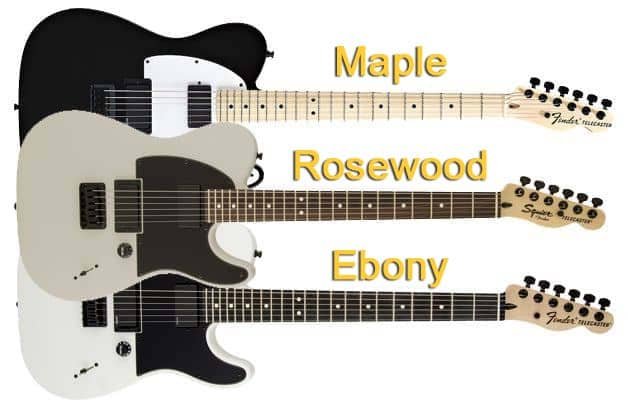
Rosewood Fretboard
Rosewood is a very versatile wood, and can be found in all types of electric guitars. This wood provides a warmer sound compared to ebony or maple wood.
These would be the most classic and historically used woods in the manufacture of fingerboards. But precisely because of this, these woods are increasingly scarce. Above all, in the case of rosewood and ebony, currently being replaced by other woods, with very similar musical qualities such as Pau Ferro.
Pau Ferro Fretboard
Pau ferro, as its name suggests, is a hardwood that is often used as a substitute for rosewood. Although the pau ferro has a brighter tone compared to the rosewood.
Different Woods Used For Electric Guitar Neck
Since the guitar neck is usually made up of two different types of wood, we can obtain different tonalitys, depending on the mixture of these woods.
For example, a mahogany neck with a rosewood fingerboard will give us a rather warm tone. A maple neck with a rosewood fingerboard will provide a balanced tone, or we can have a defined tone with an all-maple neck.
As you can see, we can balance or enhance the tonality of the instrument, depending on the wood that we use in its manufacture.
Different Types Of Wood Used For Electric Guitar Bodies
We turn to the most used woods in the development of the guitar body. But before going into more detail, I wanted to clarify that the type and quality of the wood an instrument is made of is where the heart of the matter, much more than the number of pieces of wood from which it is made the body.
Regarding the quality of the wood we have:
- A Grade: this would be the lowest quality wood. Therefore it is not usually specified in the characteristics of the guitar, since nobody wants to highlight the deficiencies of their product.
- AA Grade: double A wood has an acceptable quality.
- AAA Grade: triple A wood enjoys optimal quality. So it is usually detailed in the specifications of the instrument in question, as a prominent feature.
- AAA+ Grade: triple A plus wood has a quality similar to triple A, but applied to exotic woods of a decorative nature.
Number of Pieces of Wood in the Electric Guitar Body
Regarding the number of pieces that make up the body of the guitar, much has been discussed on this subject. Since the manufacture of a guitar body is more economical, as we increase the amount of pieces of wood that we use in its development.
Although honestly, this issue should not worry us excessively. Big brands like Fender or Gibson use several pieces of wood in the manufacture of their products, because the build of a guitar body in one piece is much more expensive, and maybe even inappropriate. Because if the wood is not of the highest quality, or has not undergone an optimal drying process, it can become twisted or even crack.
Wood Front Sheet
A guitar can appear to be made from a single piece of wood in translucent finishes. But it is simply a front sheet that hides the pieces that are underneath.
So if your guitar has an opaque finish, and you are thinking of removing it to give it a translucent or natural finish, I suggest you don’t do it, unless you don’t mind showing the different sections of the guitar body.
Do Several Glued Pieces of Wood Provide More Resistance?
The union of several pieces of wood provides greater resistance and stability than a single piece that is more prone to twisting. You have the proof in the thin necks developed by brands such as Ibanez, in various pieces of glued wood, to offer extra strength and stability, impossible to achieve in a one-piece neck.
So I would not pay much attention to the advertising of high-end guitars made in a single piece, and I challenge the expert with the best hearing on the planet, to distinguish between the same guitar made in a single piece of wood, in three , or in five.
Electric Guitar Body: Classic Woods
As it cannot be otherwise, the most classic woods in the manufacture of the guitar body would be those used by Fender such as Alder or Ash, and the classic wood used by Gibson: Mahogany.
Alder Wood
Alder is a light wood, with good qualities in terms of resonance, despite being a soft wood. The alder has a good response in both treble and bass, leaving the midrange in the background. This wood would be standard on vintage-style Strat and Telecaster-style models.
Swamp Ash
Another wood widely used in the guitar models mentioned above is swamp ash, which is more porous than other types of ash. A wood with very good sound qualities, apart from offering greater comfort due to its low weight. In addition, it has an attractive veining, and is often used in transparent or translucent finishes. This wood has a better midrange response than alder, and the basses and trebles are somewhat smoother.
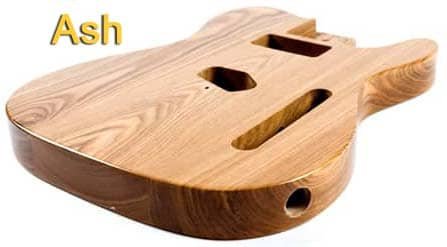
Mahogany Wood
The Mahogany is the star on the body of the Les Paul models, but it is usually accompanied by a flame maple top. Mahogany is a heavy wood compared to the previous ones, but with very good musical qualities. Since it has a very good resonance, and a warm and full-bodied tone. The flamed maple adds an attractive decorative touch.
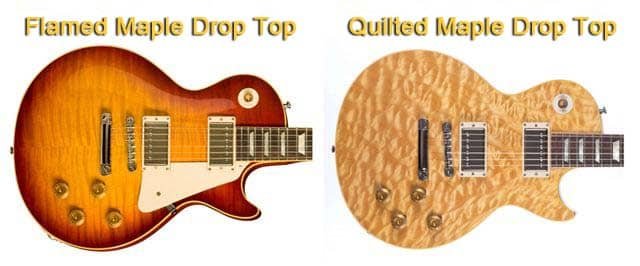
Quilted maple has the same qualities as other types of maple, but it has another decorative pattern, widely used on superstrat guitar models.
Basswood
Wood widely used in superstrat style models, and Fender style. This wood is one of the most versatile, since it has a very balanced tone, without stridency. It also works very well with both single and double pickups. For this reason it is a wood widely used in superstrat guitars, and in mixed configurations of single and double pickups.
Korina or Limba
For transparent finishes and with characteristics similar to mahogany, we have the Korina or Limba. With a nice veining, and very good sound qualities for a guitar body.
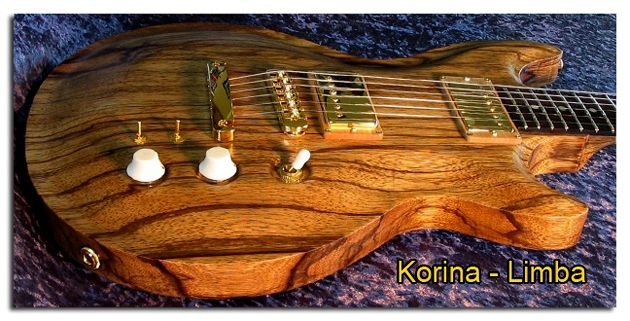
Current Alternatives to Classical Woods in the Body Guitar
As has been commented, the scarcity of traditional woods increasingly affects the manufacture of electric guitars. Consequently, there is no other option than to look for alternatives. For example, swamp ash is increasingly scarce, and Fender has been forced to do without this type of wood in many of its models. He only uses what little swamp ash he can get, for his most select models.
American Pine
A replacement wood for classic woods is American pine. Something that should not scare us, since Fender developed its first electric guitar models with American pine bodies. When the manufacturer had to increase its production due to high demand, it opted for other woods that ironically were very easy to get at that time, such as alder and ash.
Sassafras
Sassafras wood bears a strong resemblance to swamp ash, both aesthetically and acoustically.
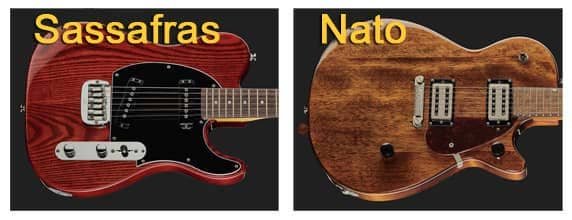
Poplar Wood
The Poplar wood is also used for the build of the guitar body, as in the case of the models developed by G&L, and also in Fender Squire models.
Poplar has similar musical qualities to basswood, but is often used in low-cost guitars due to its cheaper price. But who knows, maybe in the year 2095, when we have exhausted almost all the poplar, this wood will be used in high-end guitars.
Nato Wood
Instead of mahogany in low-cost guitars, Nato wood is commonly used. Since it is a much more abundant subspecies of mahogany, and therefore easier to obtain.
Types of Neck/Body Joints on the Electric Guitar
We move on to the types of joints between the neck and the body of the guitar. Something that can affect the resonance of the instrument, depending on the type in question.
Regarding the types of joints between the neck and the body of the electric guitar, we have three groups: Bolt-on, Set-in, and Neck-thru.
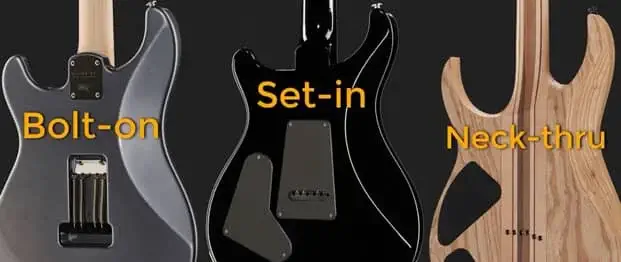
These three types of joint are usually specified in the guitar’s characteristics.
Bolt-on Neck
As far as bolt-on necks are concerned, we find two general types. Those that use a metal plate very much in the style of Fender guitars, and those that do without this plate like many Ibanez models. In the latter, the screws are embedded in recesses applied to the wood. In this way, access to the last frets of the guitar is more comfortable.
The metal plate itself has evolved, and currently many models have a plate with one of its rounded corners, to facilitate access to that part of the neck.
The screwed or Bolt-on joint would be the least expensive to produce, and in the event of a break, the replacement of the neck would be more feasible than a repair. If we were not satisfied with the fingerboard radius of our guitar, it would also be the ideal neck to be able to replace it with another with a different fingerboard radius.
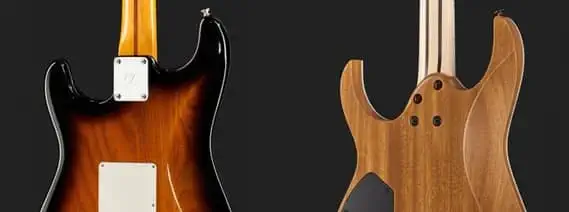
On the other hand, this type of joint has less natural resonance, since the contact between neck and body is less. Although I already tell you, that by raising the distortion level of our pedals or amplifier, we will not have problems of this type.
Set-in Neck
Set-in necks have a more optimized resonance, but their development is more complex and therefore more expensive. If there was any breakage, it would be necessary to compare between its repair, or replacement. Since replacing an entire set-in neck will be somewhat expensive.
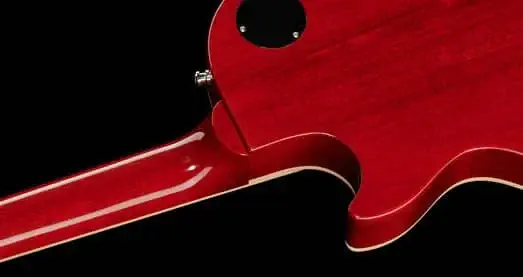
Neck-thru
Finally we have the neck-thru joint. This joint is the most complicated and expensive to produce, surpassing other types of joints in resonance and comfort in access to the last frets. Since a transition between body and neck can be applied very smooth.
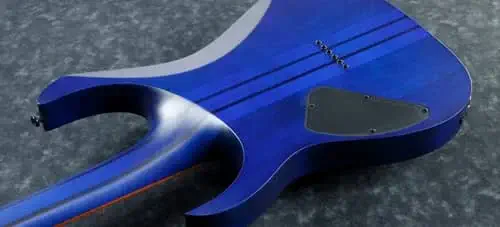
On the contrary, in the event of a possible breakage of the neck, we would only have the recourse of repair, since the replacement of the neck could not be carried out.
